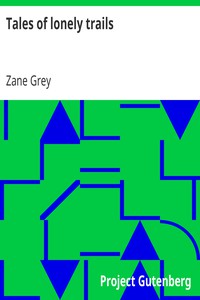Tales of lonely trails by Zane Grey (free novel 24 .TXT) 📕

Read free book «Tales of lonely trails by Zane Grey (free novel 24 .TXT) 📕» - read online or download for free at americanlibrarybooks.com
- Author: Zane Grey
Read book online «Tales of lonely trails by Zane Grey (free novel 24 .TXT) 📕». Author - Zane Grey
An hour later we broke camp. Traveling in the early morning was pleasant and we made good time down the winding canyon, arriving at Furnace Creek about noon, where we halted to rest. This stream of warm water flowed down from a gully that headed up in the Funeral Mountains. It had a disagreeable taste, somewhat acrid and soapy. A green thicket of brush was indeed welcome to the eye. It consisted of a rank coarse kind of grass, and arrowweed, mesquite, and tamarack. The last named bore a pink fuzzy blossom, not unlike pussy-willow, which was quite fragrant. Here the deadness of the region seemed further enlivened by several small birds, speckled and gray, two ravens, and a hawk. They all appeared to be hunting food. On a ridge above Furnace Creek we came upon a spring of poison water. It was clear, sparkling, with a greenish cast, and it deposited a white crust on the margins. Nielsen, kicking around in the sand, unearthed a skull, bleached and yellow, yet evidently not so very old. Some thirsty wanderer had taken his last drink at that deceiving spring. The gruesome and the beautiful, the tragic and the sublime, go hand in hand down the naked shingle of this desolate desert.
While tramping around in the neighborhood of Furnace Creek I happened upon an old almost obliterated trail. It led toward the ridges of clay, and when I had climbed it a little ways I began to get an impression that the slopes on the other side must run down into a basin or canyon. So I climbed to the top.
The magnificent scenes of desert and mountain, like the splendid things of life, must be climbed for. In this instance I was suddenly and stunningly confronted by a yellow gulf of cone-shaped and fan-shaped ridges, all bare crinkly clay, of gold, of amber, of pink, of bronze, of cream, all tapering down to round-knobbed lower ridges, bleak and barren, yet wonderfully beautiful in their stark purity of denudation; until at last far down between two widely separated hills shone, dim and blue and ghastly, with shining white streaks like silver streams—the Valley of Death. Then beyond it climbed the league-long red slope, merging into the iron-buttressed base of the Panamint Range, and here line on line, and bulge on bulge rose the bold benches, and on up the unscalable outcroppings of rock, like colossal ribs of the earth, on and up the steep slopes to where their density of blue black color began to thin out with streaks of white, and thence upward to the last noble height, where the cold pure snow gleamed against the sky.
I descended into this yellow maze, this world of gullies and ridges where I found it difficult to keep from getting lost. I did lose my bearings, but as my boots made deep imprints in the soft clay I knew it would be easy to back-track my trail. After a while this labyrinthine series of channels and dunes opened into a wide space enclosed on three sides by denuded slopes, mostly yellow. These slopes were smooth, graceful, symmetrical, with tiny tracery of erosion, and each appeared to retain its own color, yellow or cinnamon or mauve. But they were always dominated by a higher one of a different color. And this mystic region sloped and slanted to a great amphitheater that was walled on the opposite side by a mountain of bare earth, of every hue, and of a thousand ribbed and scalloped surfaces. At its base the golds and russets and yellows were strongest, but ascending its slopes were changing colors—a dark beautiful mouse color on one side and a strange pearly cream on the other. Between these great corners of the curve climbed ridges of gray and heliotrope and amber, to meet wonderful veins of green—green as the sea in sunlight—and tracery of white—and on the bold face of this amphitheater, high up, stood out a zigzag belt of dull red, the stain of which had run down to tinge the other hues. Above all this wondrous coloration upheaved the bare breast of the mountain, growing darker with earthy browns, up to the gray old rock ramparts.
This place affected me so strangely, so irresistibly that I remained there a long time. Something terrible had happened there to men. I felt that. Something tragic was going on right then—the wearing down, the devastation of the old earth. How plainly that could be seen! Geologically it was more remarkable to me than the Grand Canyon. But it was the appalling meaning, the absolutely indescribable beauty that overcame me. I thought of those who had been inspiration to me in my work, and I suffered a pang that they could not be there to see and feel with me.
On my way out of this amphitheater a hard wind swooped down over the slopes, tearing up the colored dust in sheets and clouds. It seemed to me each gully had its mystic pall of color. I lost no time climbing out. What a hot choking ordeal! But I never would have missed it even had I known I would get lost. Looking down again the scene was vastly changed. A smoky weird murky hell with the dull sun gleaming magenta-hued through the shifting pall of dust!
In the afternoon we proceeded leisurely, through an atmosphere growing warmer and denser, down to the valley, reaching it at dusk. We followed the course of Furnace Creek and made camp under some cottonwood trees, on the west slope of the valley.
The wind blew a warm gale all night. I lay awake a while and slept with very little covering. Toward dawn the gale died away. I was up at five-thirty. The morning broke fine, clear, balmy. A flare of pale gleaming light over the Funeral Range heralded the sunrise. The tips of the higher snow-capped Panamints were rose colored, and below them the slopes were red. The bulk of the range showed dark. All these features gradually brightened until the sun came up. How blazing and intense! The wind began to blow again. Under the cottonwoods with their rustling leaves, and green so soothing to the eye, it was very pleasant.
Beyond our camp stood green and pink thickets of tamarack, and some dark velvety green alfalfa fields, made possible by the spreading of Furnace Creek over the valley slope. A man lived there, and raised this alfalfa for the mules of the borax miners. He lived there alone and his was indeed a lonely, wonderful, and terrible life. At this season a few Shoshone Indians were camped near, helping him in his labors. This lone rancher's name was Denton, and he turned out to be a brother of a Denton, hunter and guide, whom I had met in Lower California.
Like all desert men, used to silence, Denton talked with difficulty, but the content of his speech made up for its brevity. He told us about the wanderers and prospectors he had rescued from death by starvation and thirst; he told us about the terrific noonday heat of summer; and about the incredible and horrible midnight furnace gales that swept down the valley. With the mercury at one hundred and twenty-five degrees at midnight, below the level of the sea, when these furnace blasts bore down upon him, it was just all he could do to live. No man could spend many summers there. As for white women—Death Valley was fatal to them. The Indians spent the summers up on the mountains. Denton said heat affected men differently. Those who were meat eaters or alcohol drinkers, could not survive. Perfect heart and lungs were necessary to stand the heat and density of atmosphere below sea level. He told of a man who had visited his cabin, and had left early in the day, vigorous and strong. A few hours later he was found near the oasis unable to walk, crawling on his hands and knees, dragging a full canteen of water. He never knew what ailed him. It might have been heat, for the thermometer registered one hundred and thirty-five, and it might have been poison gas. Another man, young, of heavy and powerful build, lost seventy pounds weight in less than two days, and was nearly dead when found. The heat of Death Valley quickly dried up blood, tissue, bone. Denton told of a prospector who started out at dawn strong and rational, to return at sunset so crazy that he had to be tied to keep him out of the water. To have drunk his fill then would have killed him! He had to be fed water by spoonful. Another wanderer came staggering into the oasis, blind, with horrible face, and black swollen tongue protruding. He could not make a sound. He also had to be roped, as if he were a mad steer.
I met only one prospector during my stay in Death Valley. He camped with us. A rather undersized man he was, yet muscular, with brown wrinkled face and narrow dim eyes. He seemed to be smiling to himself most of the time. He liked to talk to his burros. He was exceedingly interesting. Once he nearly died of thirst, having gone from noon one day till next morning without water. He said he fell down often during this ordeal, but did not lose his senses. Finally the burros saved his life. This old fellow had been across Death Valley every month in the year. July was the worst. In that month crossing should not be attempted during the middle of the day.
I made the acquaintance of the Shoshone Indians, or rather through Nielsen I met them. Nielsen had a kindly, friendly way with Indians. There were half a dozen families, living in squalid tents. The braves worked in the fields for Denton and the squaws kept to the shade with their numerous children. They appeared to be poor. Certainly they were a ragged unpicturesque group. Nielsen and I visited them, taking an armload of canned fruit, and boxes of sweet crackers, which they received with evident joy. Through this overture I got a peep into one of the tents. The simplicity and frugality of the desert Piute or Navajo were here wanting. These children of the open wore white men's apparel and ate





Comments (0)